Market snapshot
- ASX 200: -0.8% to 7,898 points (live values below)
- Australian dollar: -0.08% to 62.74 US cents
- S&P 500: -2.7% to 5,614 points
- Nasdaq: -4% to 17,468 points
- FTSE: -0.9% to 8,600 points
- EuroStoxx: -1.3% to 546 points
- Spot gold: +0.24% to $US2,896/ounce
- Brent crude: -0.64% at $US72.57/barrel
- Iron ore: $US100.99/tonne
- Bitcoin: +0.45% to $US79,633
Prices current around 2:55pm AEDT.
Live updates on the major ASX indices:
Austal proposes a securities purchase plan
Is there any update regarding AUSTAL?
– Andy Smith
Hi Andy,
AUSTAL was placed in a trading halt before the market opened this morning.
But within the last hour it’s published three market announcements that relate to that trading halt:
- 1.A $200 million institutional placement to expand its US capacity
- 2.Its $200m institutional placement investor presentation
- 3.An offer of securities under a securities purchase plan.
You can find the announcements in this link:
A deep breath
A 10% market drop pales compared to the many multiples of that rise in the market over the past few years. It’s not meant to go straight up indefinitely.
– Craig
Very true.
When you step back and look at how the ASX200 index has performed since 2006, it puts things into perspective.
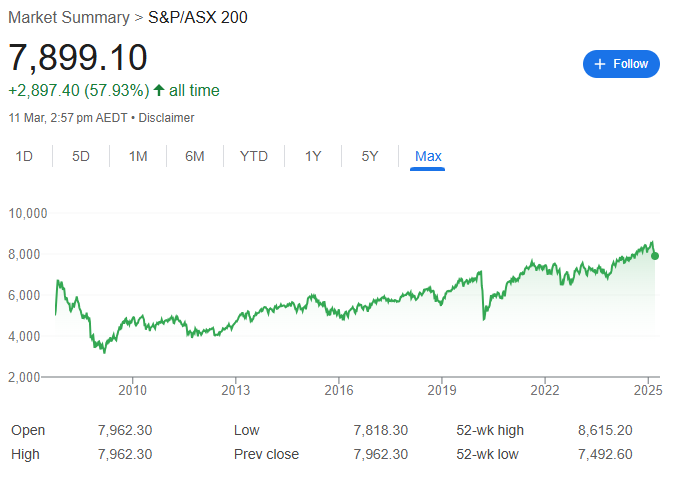
When could the US enter recession?
Hi team. I know it is early days but if the US does enter a recession, when would we know? Could we enter a recession if the US does? Is the saying “when America sneezes, Australia catches a cold” still true in Trump 2.0? Keep up the great work.
– Eric
It depends how you define recession.
In the US, the National Bureau of Economic Research (NBER) is widely considered to be the authority for calling a recession.
This is its definition:
“A recession involves a significant decline in economic activity that is spread across the economy and lasts more than a few months.”
In Australia and many other countries, a recession is widely considered to be two consecutive quarters of economic contraction as measured by GDP.
The first quarter US GDP data is out on April 30 and the second quarter data is out on July 30.
So, on the Australian definition, we won’t know for sure whether the US has entered a recession during the early months of the Trump presidency until then.
There is another measure of recession, which is the Sahm rule, named after US economist Claudia Sahm.
It defines a recession as starting when the three-month moving average of the national unemployment rate rises by 0.5 percentage points or more relative to the minimum of the three-month averages from the previous 12 months.
If you accept this rule, which even its creator Claudia Sahm says has serious limitations, then the US entered recession in July last year. She did not believe the US was already in recession last year.
Readers respond to market turmoil
My family is all in the US. My parents have just bought a cheaper place with a much cheaper HOA (body corporate.) My sisters, who have good jobs, are economising wherever they can. The only family that isn’t worried are the MAGAs who are literally one Social Security check away from homelessness – but they seem to think this is all good for the economy (and for them.) It boggles the mind.
– Quimby
Oh dear. I’m sure very few will be happy about the path of happenings in the US. I’m getting burnt. Surely there had to be a detox at some point. Can’t keep spending on the never never for ever ever. Flak jacket on!
– Peter
This day is chaos. The best bet is as the film WarGames says – the only winning move is not to play.
– Ermi
Australia should declare neutrality, cancel AUKUS and build thousands of uncrewed subs. Reassuring China and Indonesia that we are defenders not attackers. And give Malcolm Turnbull a medal for stating the bleeding obvious. It sure needed to be said.
– Gordon Cope
Thanks for sending your comments into the blog today. Here’s a variety that touch on the same theme.
Consumer group says scam losses are ‘deeply concerning’
The Consumer Action Law Centre says the amount of money Australians lost to scams last year is “deeply concerning”.
A report from the National Anti-Scam Centre found losses from scams fell almost 26 per cent, to $2 billion, in 2024.
The consumer group’s CEO Stephanie Tonkin says while the reduction in losses is positive, it’s still a huge sum which involved almost half a million victims, in the midst of a cost-of-living crisis.
“This loss was almost totally borne by the victims who have no simple path available for reimbursement or justice,” she said.
She said it’s likely the figure is an underestimate, as 30 per cent of victims do not report their losses.
The report also reveals losses for First Nations Australians increased by more than 70 per cent, to $6.5 million, while the number of First Nations people reporting scams fell overall (meaning fewer people reporting larger amounts).
Ms Tonkin says recent Federal Government anti-scam laws are a good step forward, but the changes will not be implemented until 2026.
“Today’s report underlines why we need action to stop scams now and a simple and effective pathway for victims to get redress.”
Claims numbers rise as clean-up begins following tropical cyclone Alfred
The Insurance Council of Australia (ICA) says insurers have received more than 22,000 insurance claims from policyholders across southeast Queensland and northern New South Wales following ex-Tropical Cyclone Alfred.
It says the majority of claims are from Queensland, but claim numbers across New South Wales are expected increase in coming days as some areas reopen:

It says it’s still too early to estimate what the total damage bill for TC Alfred will be.
It says the last cyclone to hit Australia, Tropical Cyclone Jasper (2023), cost $409 million from around 10,500 claims.
The costliest cyclone to hit Australia remains Cyclone Tracy (1974), which normalised to 2023 values would incur $7.4 billion in claims.
The floods of early 2022 remain the costliest insured event in Australia’s history with $6.4 billion in insured losses across more than 245,000 claims.
Financial losses from scams have fallen, but still cost Australians $2 billion
Financial losses from scams fell almost 26 per cent last year, to $2 billion, according to a report by the National Anti-Scam Centre.
The number of scams reported also fell by almost 18 per cent to just under 500,000 for the year.
The top five types of scams were investment, romance, payment redirection, remote access and phishing schemes, which made up more than 70 per cent of the total combined losses.
Investment scams resulted in the highest overall combined losses, with $945 million lost in 2024.
“We continue to be concerned about the high individual losses and emotional impact of scams,” said ACCC Deputy Chair Catriona Lowe.
The National Anti-Scam Centre combines data from Scamwatch, ReportCyber, the Australian Financial Crimes Exchange, IDCARE and Australian Securities and Investments Commission (ASIC).
ACCC Deputy Chair Catriona Lowe says a key reason for the decrease in reported losses is because the organisations are working together “actioning and intelligence we and partners receive through reports”.
“While we are encouraged by the drop in reported financial losses, we acknowledge scammers are sophisticated and highly motivated criminals,” she said.
” We urge Australians to never take investment advice or give money to people they have only met online.”
You’re in the right place
I’m confused as to why there’s not much serious in-depth reporting on how dire things are in the markets at the moment. 17 days now of falls, almost 10% down with very little upside. Where’s the bottom? And when will a reversal likely happen? Peoples super accounts are being drained by thousands everyday. Shouldn’t the alarm bells be ringing?
– TrendyLion
Hi TrendyLion, if you’re looking for serious reporting, you’ve come to the right place.
Totally agree there are some deeply concerning trends, such as the breadth as well as depth of declines on the S&P 500 overnight, but you do have to put the current falls in the context of a very strong Trump election rally.
So far, the markets are just giving up those recent gains, perhaps as they re-evaluate just how beneficial the Trump presidency really will be for a lot of corporate America.
You’ll be glad to know that tonight’s episode of The Business is almost all devoted to the share market turmoil, except for an interview with Bally chair Soo Kim, whose company is one of those with an offer on the table to rescue Star Entertainment.
If you want to read some more in the meantime, can I commend my colleague David Taylor’s piece on the market reaction to growing fears of a Trump-driven US recession.
Petrol prices fall 1.6 cents in the past week
Hi team,
Just jumping in with my weekly look at petrol prices. The latest figures from the Australian Institute of Petroleum has the average national prices of a litre of unleaded petrol at 183.7 cents, slightly lower than the average for the previous week, month and the 12-months to now.
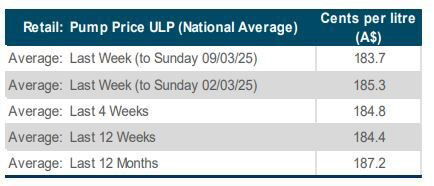
There was some bounce around in the states, with the averages quite wide.
NSW / ACT was at 183.7 cents (up +3.7%) Victoria at 180.3 cents (-5.4%), Queensland at a pre-Cyclone 193.7 cents (-3.3%) South Australia worth a drive to if you’re not there at 173.9 cents, (-8.4%!) Western Australia on 179.5 cents (-0.5%) Northern Territory an oft-scorching 197.1 cents (+0.5%) and Tasmania on 186.1 cents (-0.4%).
Why don’t we see TV footage of Australia’s trading floor?
Why do we see images and film clips from the floor of Wall Street, yet nothing from inside our very own ASX? Is the all the trading that occurs in Australia required to be completed behind closed doors?
– Will
Hi Will,
Good question. There’s no trading floor in Australia anymore. There hasn’t been for many, many years.
The trading that occurs on the ASX takes place in a purpose built data-centre.
It’s called the ASX Australian Liquidity Centre (Co-Location Facility), and it’s in Gore Hill, which is nine kilometres north-west of Sydney’s CBD.
This is what it looks like:

That’s why we don’t have TV crews in there. And they wouldn’t see much anyway, unless you want to see rows and rows of (what look like) hard drives being cooled down by fans.
And when it comes to Wall Street, that old trading floor is largely for show now. It’s set up for TV cameras and visitors to come to see the “action” on a busy day.
But just like in Australia, the real trading on Wall Street takes place in co-location facilities these days.
Market snapshot
- ASX 200: -1.46% to 7,845 points (live values below)
- Australian dollar: -0.13% to 62.71 US cents
- S&P 500: -2.7% to 5,614 points
- Nasdaq: -4% to 17,468 points
- FTSE: -0.9% to 8,600 points
- EuroStoxx: -1.3% to 546 points
- Spot gold: +0.03% to $US2,890/ounce
- Brent crude: -0.64% at $US72.57/barrel
- Iron ore: $US100.99/tonne
- Bitcoin: -0.75% to $US78,684
Prices current around 12:45pm AEDT.
Live updates on the major ASX indices:
The mean price of Australia’s residential dwellings declines in December quarter
The total value of Australia’s residential dwellings stabilised in the last six months of 2024.
According to the Bureau of Statistics, their total value rose by $26.4 billion in the December quarter, to $11.03 trillion.
“The relatively flat growth for the December quarter was the result of net additions to stock offsetting a slight fall in property prices,” Dr Mish Tan, ABS head of finance statistics, said.
The number of residential dwellings rose by 53,200 to 11,294,300 in the December quarter.
But the mean price of residential dwellings fell by $2,300 to $976,800.
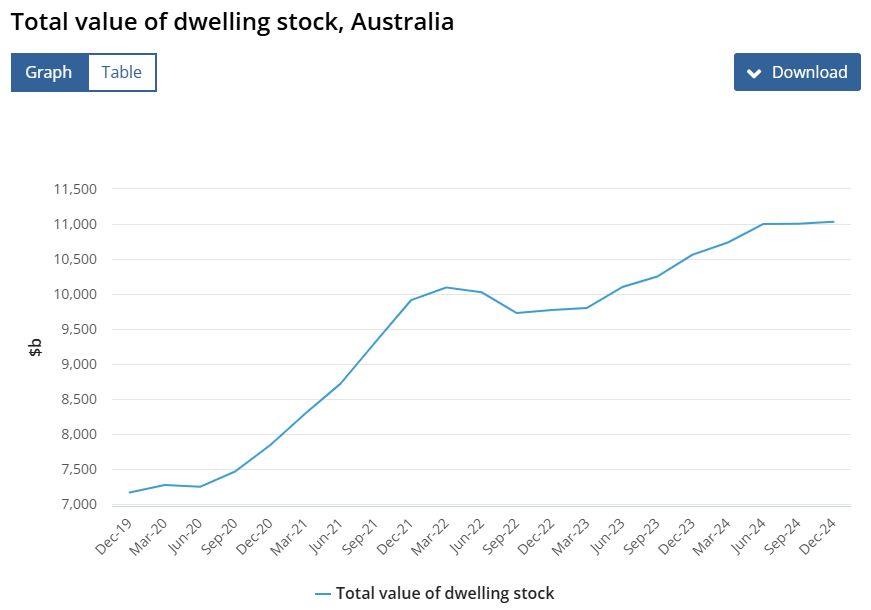
The December quarter 2024 saw mixed results across the states and territories, with the total value of residential dwellings rising in:
- South Australia (+2.4%)
- Queensland (+1.8%)
- Western Australia (+1.8%)
- Tasmania (+1.2%)
- Australian Capital Territory (+0.4%)
- Northern Territory (+0.3%).
But the value of dwellings fell in:
- New South Wales (-0.4%)
- Victoria (-1.1%).
The mean price of residential dwellings in New South Wales ($1,214,100) remains the highest in the country, followed by the Australian Capital Territory ($956,800).
Queensland ($923,600) has the third largest mean price in the country, while the lowest mean price remains in the Northern Territory ($500,900).
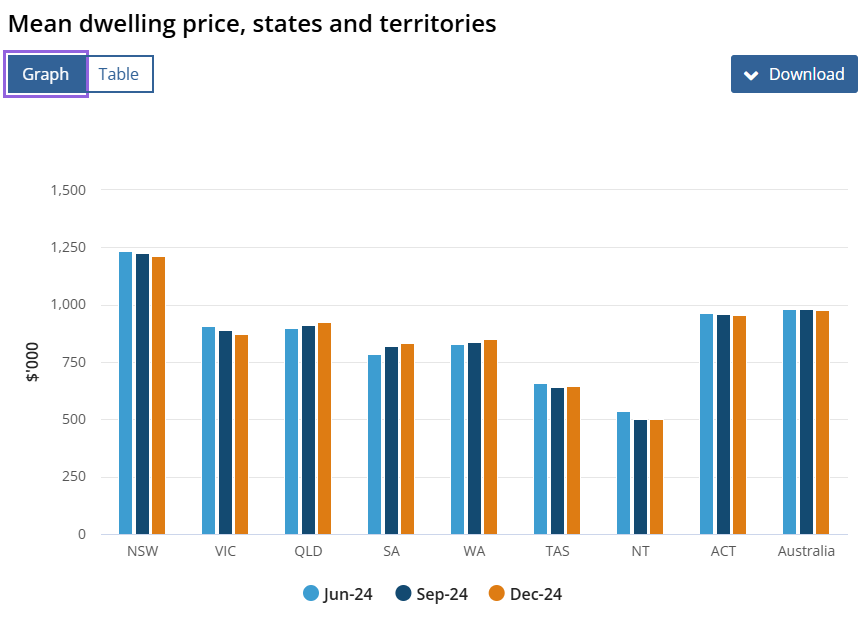
Is the US heading towards recession?
US markets tanked overnight after US President Donald Trump declined to talk down the prospect of a recession.
Wall Street’s main S&P 500 index tumbled 2.7 per cent while the Nasdaq fell 4 per cent.
Economists warn spending cuts and policy ‘chaos’ are driving the US towards a recession.
You can read more here:
About $50 billion has been wiped off the Australian share market this morning.
The All Ordinaries is down about -1.94% to 8,032 points, and the ASX 200 is down -1.8% to 7,820 as at 12.14pm AEDT.
The sectors continue to be fairly red, with IT the worst hit.

You can check live updates here:
When was that survey done?
When was that sentiment survey done? There seems to be a lot of stressed people aged over 60 this week given stock market movements.
– Troy
Hi Troy,
The Westpac-Melbourne Institute survey was conducted last week (from Monday 3 to Friday 7 March, inclusive).
One-third of households expect another rate cut this year
Let’s dig into that Westpac-Melbourne Institute consumer sentiment survey a little more.
The table below shows the headline number for the consumer sentiment index, and the various sub-indexes that feed into it.
I’ve highlighted the March 2025 column in yellow so it’s easier to see the results from this month, and to compare them to last month’s results.
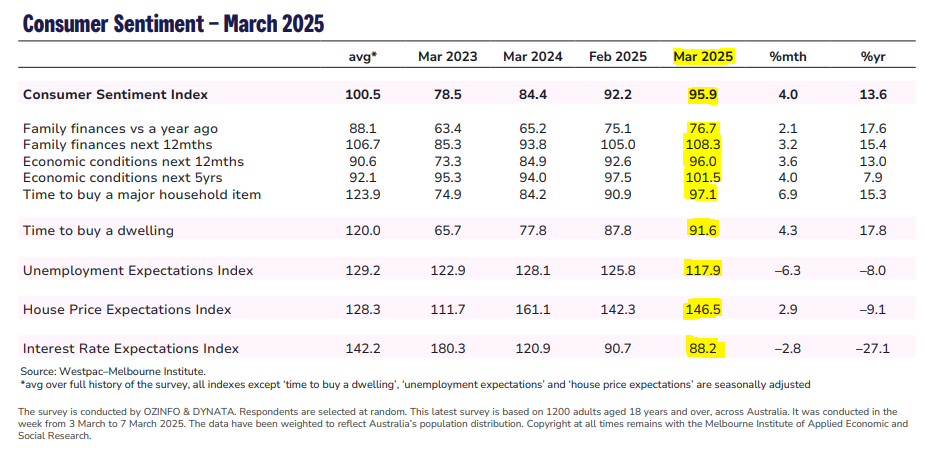
Matthew Hassan, the head of Australian macro-forecasting at Westpac, says the “interest rates expectations index”, which tracks consumer expectations for variable mortgage rates over the next 12 months, declined by 2.2% in March to 88.2 – which is a new cycle low.
Ms Hassan says the details in the survey show 36% of consumers expect mortgage rates to decline over the next year, while 22% expect no change and 26% expect rates to move higher.
He says consumers are also becoming more positive on the labour market, with expectations suggesting the Reserve Bank’s “soft landing” has already been achieved.
“The Westpac–Melbourne Institute Unemployment Expectations Index dropped 6.3% to 117.9 in March (recall that lower index reads mean more consumers expect unemployment to fall over the year ahead),” he says.
“The Index is at its lowest level since the start of 2023 and comfortably below the long run average index read of 129. The unemployment rate has held steady around 4% since mid-2024.”
Consumers views on housing also improved in March.
“The RBA’s February rate cut drove a solid lift homebuyer sentiment.
“The ‘time to buy a dwelling’ index rose 4.3% to 91.6. While that still means pessimists outnumber optimists, this is the lowest incidence of pessimism since September 2021.
“The interest rate cuts generated particularly positive responses in Victoria – where buyer sentiment surged 15.3% to outright optimism (106) – and Western Australia where buyer sentiment bounced strongly off last month’s extreme lows (+24.6% to 89.4).
“While outright optimism remains scarce, there are now half a dozen sub-groups that are positive on ‘time to buy’ including 18–24-year-olds and consumers that own their home without a mortgage,” he said.
Mr Hassan said responses to a separate question on the ‘wisest place for savings’ suggests consumers are also becoming slightly more interested in real estate as a specific investment option and slightly less risk averse overall.
“Consumers still heavily favour ‘safe options’ with just over half (52%) nominating either ‘bank deposits’ or ‘pay down debt’ as the wisest place of savings, down only slightly from the 54% in December,” he said.
“Some 10.5% of consumers nominated ‘real estate’ – the second highest reading since March 2020, albeit still a shadow of the long run historical average of 23%.”
Westpac expects the RBA Board to leave interest rates unchanged with it next meets, on March 31-April 1.
Mr Hassan says the RBA has been clear that its decision to cut rates 25 basis points at its February meeting did not mean further reductions could be expected at subsequent meetings.
“Any cuts from here will instead depend on the flow of data, especially for inflation, the labour market and domestic demand,” he said.
Gloomy vibes at ASX central
Daniel Irvine, one of our star camera operators and photographers, has captured the ~vibe~ down at the ASX on a fairly grey and gloomy day in Sydney.
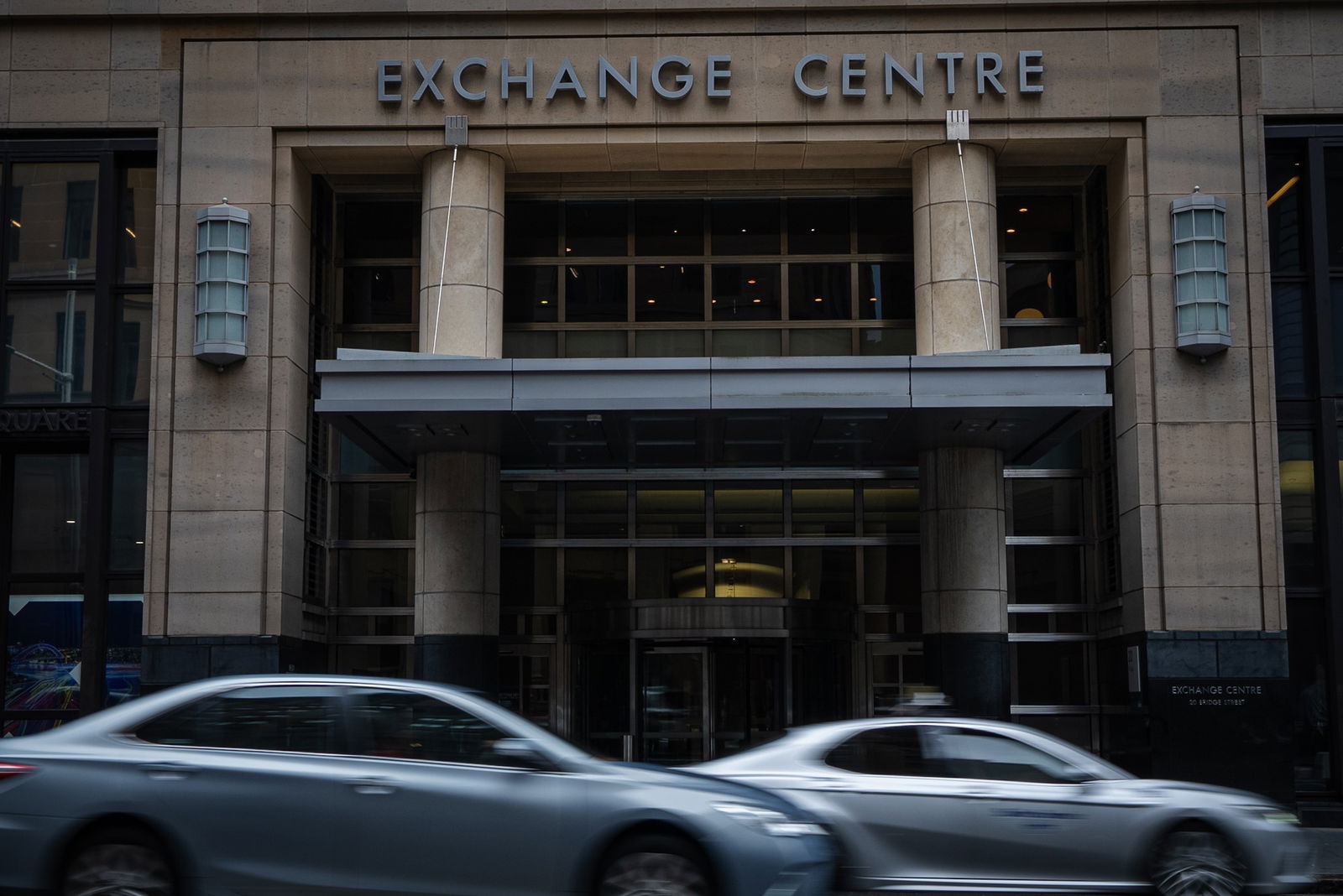
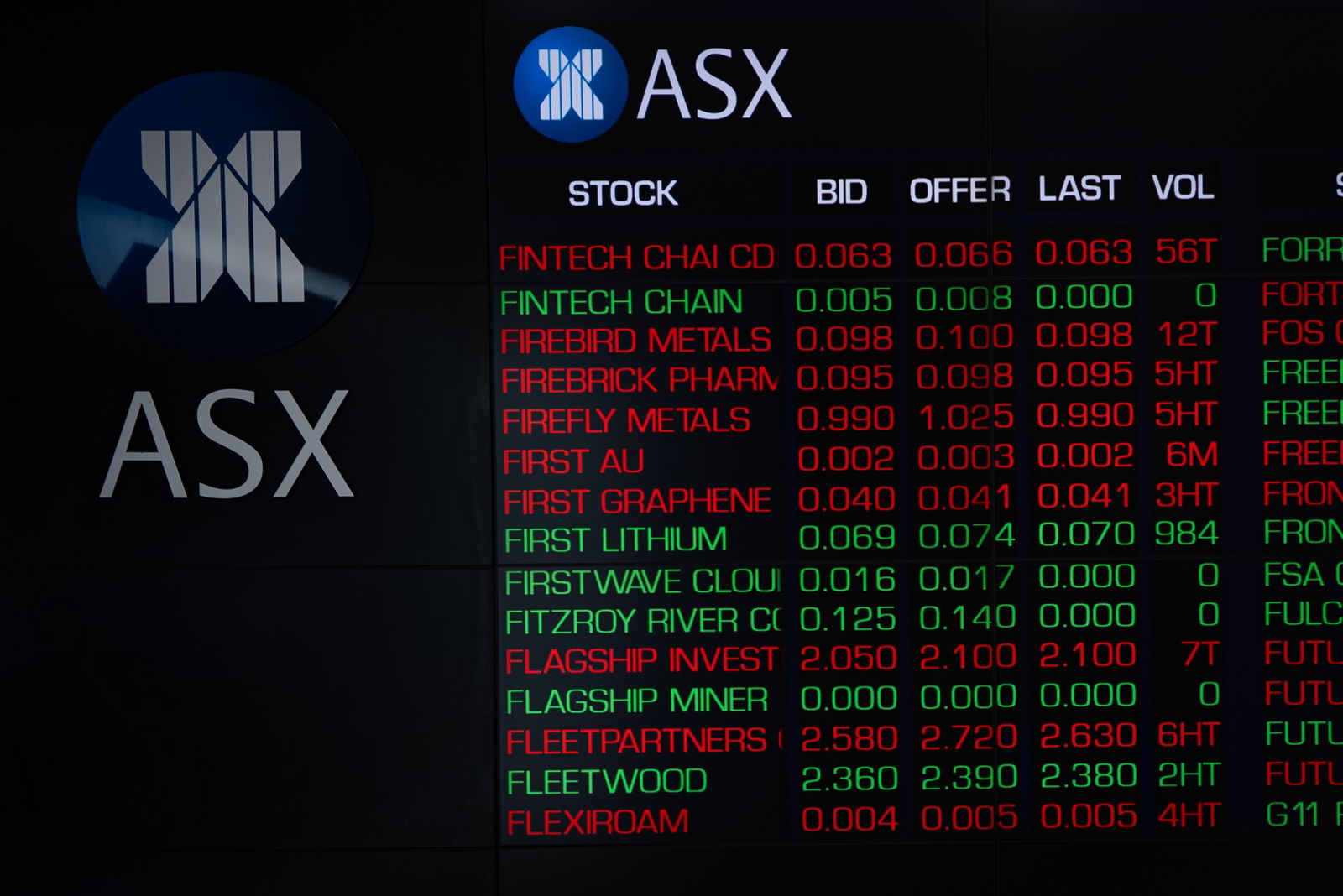
Not quite Wall Street trading floor mayhem, but if you listen really carefully you can kind of hear the mouse clicks as people hit the sell button. Maybe…
What’s mine is yours
So if I spend $10 cash on fruit today, then next week the bottom of the fridge has turned into a compost heap, I believe it’s a non-cash impairment as I write the value of the fruit down to zero, even though it’s last week’s cash I just wasted. Or does it only work that way if I only open the fridge next year to see what happened to the fruit?
– Bof
If you were circular economy-minded, you’d sell that compost heap to someone else and use the money to buy more fruit.
Consumer sentiment hits three-year high in Australia
As the (unconfirmed) date of the federal election edges closer and closer, falling inflation and the Reserve Bank’s interest rate cut has clearly made people feel better about their finances.
The latest Westpac-Melbourne Institute consumer sentiment survey shows consumer sentiment has just hit a three-year high.
“The recovery in consumer sentiment, which began in the second half of last year but lost its way a little over the Christmas–New Year period, regained momentum in March,” said Matthew Hassan, head of Australian macro-forecasting at Westpac.
“The RBA’s decision to cut interest rates in February and a further easing in cost-of-living pressures have provided a clear lift.
“The survey detail shows a broad-based improvement with a notable rise in confidence around the labour market outlook.
In the graph below, the number 100 is the “neutral” level where there are the same number of optimists and pessimists.
The index is currently sitting at 95.9, which means there are still more pessimists in the economy. But the trend is a positive one. The number of pessimists are dwindling.
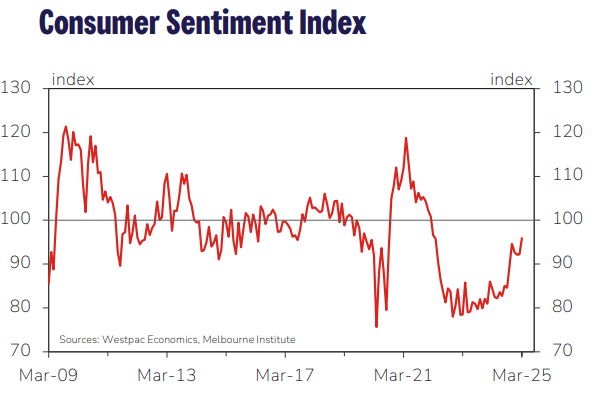
Mr Hassan says there’s still a lot of room for improvement too.
“There are still some signs of unease, particularly around developments abroad.
“Our March, June, September and December surveys include additional questions on news recall. Responses in March show that while consumers detected a marked improvement in the domestic news-flow, the news from abroad has become more troubling.
“Topic-wise, news on ‘inflation’ again had the highest recall, followed by ‘budget and taxation’, ‘employment’, ‘economic conditions’ and ‘interest rates’. In all cases, most consumers still viewed the news as unfavourable but much less so than in December […]
“Assessments would have gained some moderate support from the December quarter national accounts update, released mid-way through the survey week. This showed the economy continues to track a gradual recovery, GDP rising 0.6%qtr – the first ‘per capita’ gain since 2022 – and annual growth lifting to 1.3%yr.
“Around family finances, the picture continues to be of a slow improvement but with rising optimism about the year ahead,” he said.














